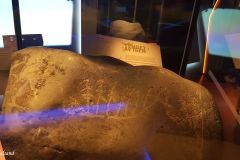Go visit the Rock Art of Alta. More than 6,000 rock carvings and paintings have been discovered in the north of Norway. They date back 2,000-7,000 years and show how the hunter-gatherers at the time viewed wildlife around them.
The UNESCO World Heritage List includes over a thousand properties. They have outstanding universal value and are all part of the world’s cultural and natural heritage.
Official facts
- Country: Norway
- Date of Inscription: 1985
- Category: Cultural
UNESCO’s World Heritage Centre’s (short) description of site no. 352:
This group of petroglyphs in the Alta Fjord, near the Arctic Circle, bears the traces of a settlement dating from c. 4200 to 500 B.C. The thousands of paintings and engravings add to our understanding of the environment and human activities on the fringes of the Far North in prehistoric times.
My visit
In or near the Northern Norway town of Alta there is a large concentration of rock art made by hunter-gatherers. There are four sites with rock carvings (at Hjemmeluft, Kåfjord, Amtmannsnes and Storsteinen) and one with rock paintings (Transfarelv). The distance between them is 15 km. When the rock art was inscribed onto the World Heritage List, the number of figures was estimated to be over 3,000. Today that number has doubled, with more than 6,000 registered figures.
There is a museum and universally accessible walkways at the largest site, in Hjemmeluft. In fact, the museum personnel will explain that the other sites are not easy to find. We are more or less discouraged from visiting them. We can understand that when we consider the fact that these pieces of art are ancient. They are also vulnerable to natural erosion and human actions. I arrived in Alta on a road trip in the region, in 2020.
The carvings at Hjemmeluft are all on quite slippery rock surfaces. Many of the carvings have red paint and easy to see. Others are unpainted and difficult to decipher, especially on a rainy day – like on our visit.














